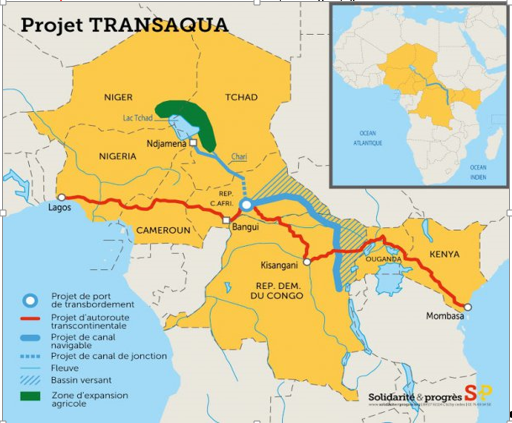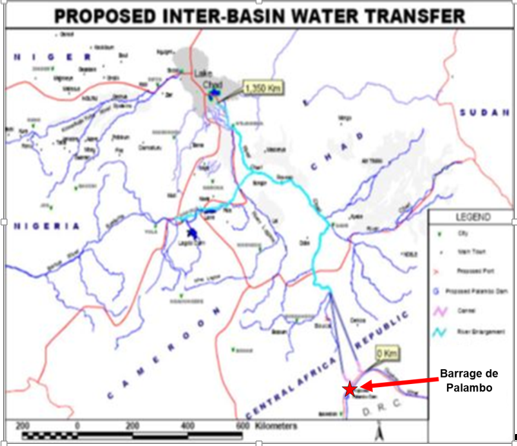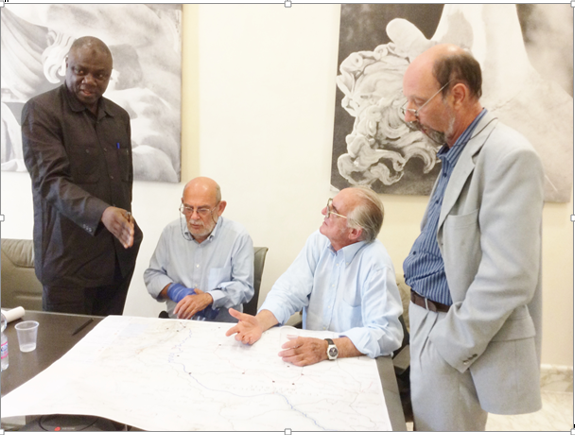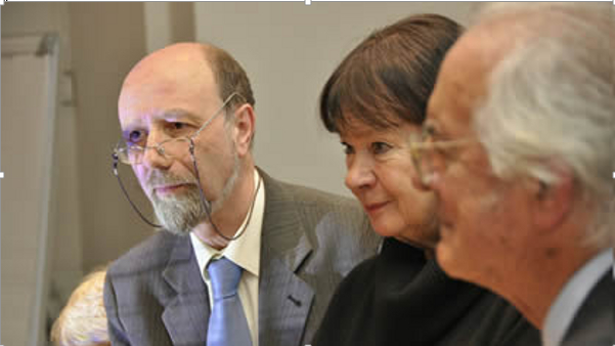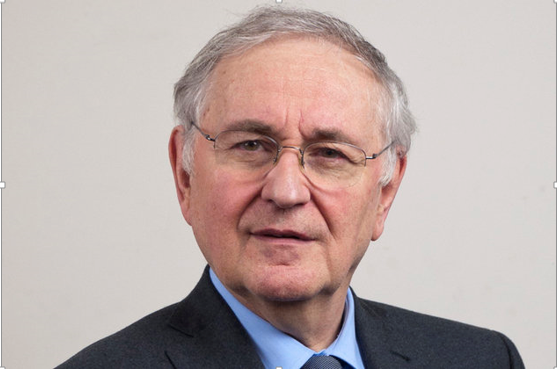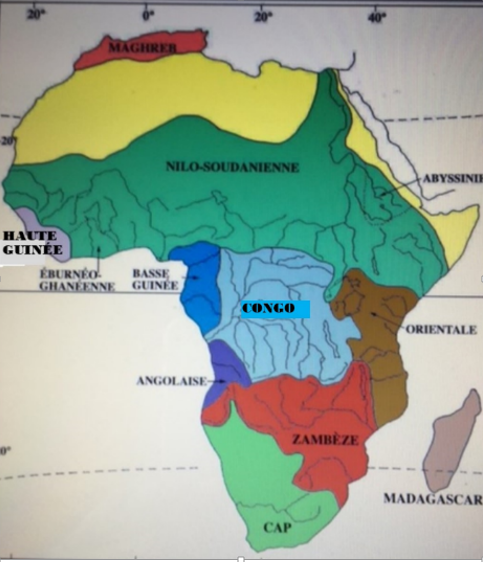After plundering minerals, soon the plundering of the Congo freshwater, the blue gold of this century
By Sinaseli TSHIBWABWA
09 August 2017
The supposed «disappearance» of the Lake (Chad) through water abstraction and climate
change is a popular myth that endures because it serves a large set of heterogeneous
interests, including those supporting inter-basin water transfers
Prof. Géraud Magrin, 2016[1]
Univ. Paris 1 Panthéon-Sorbonne,France
PROBLEM
From 1997 till now (two decades), the Congolese people are bewildered and disillusioned by their own extermination by the neighboring countries with the support of the Western powers and the complicity of their own sons to plunder, the minerals of the DR Congo. Whole ethnic groups are already disappearing from their lands in the east of the country, some have been driven into exile, others have been displaced from the land of their ancestors and left into inhospitable forests to facilitate peaceful access to gold, coltan, diamond, etc. (Onana1bis, Kankwenda2, Musavuli 3,4). Even within their country, their President who was imposed by the same foreign powers lead a fierce war against its own people (Musavuli5, Mwamba Tshibangu6) in flagrant violation of the Constitution. This is the case of the massacres that are still ongoing in Great Kasai as confirmed by a UN report of August 4, 20177. All international treaties and laws on territorial integrity, human rights, women’s and children’s rights, and non-assistance to persons at risk of extermination have been violated without sanctioning the perpetrators of these crimes of genocide. «Silence, we plunder and sell the blood ores at low prices» seems to be the motto of the international community! After the appropriation of the minerals, Western groups, with the complicity of some African countries, are now reactivating two projects of plundering water in the Congo River Basin for supposedly fighting famine, desertification and drying up of Lake Chad8.
As a reminder, the first project (Transaqua), developed by the Italian Bonifica engineering firm in 1972, proposes to build regulation dams on several tributaries of the Congo River in the east and north-east of the DR Congo including the following rivers: Lowa, Lindi, Aruwimi, Maïko, Tshopo, Itimbiri, Mongala, and the tributaries of the Oubangui River : Giri, Lua and Kotto. A gigantic channel would cross the inter-basin natural barrier of 600 meters of elevation, and the waters thus subtracted from the Congo River basin9 will be dumped in Chad Lake via the Chari River (see Fig. 1).
Fig.1. In blue: the channel layout; the hatched area: Water catchment zone of the Transaqua Project (Source: Jacques Cheminade, 28 December 201610 )
NB: In September 2015, Mr. Vichi readjusted his plans for Transaqua: «the catchment area will encompass all tributaries on the right bank of the Congo River in south of the DR Congo. The longer the canal, the greater the volume of water to be discharged into the lake! »
The second project (Project Oubangui), developed by members of the Lake Chad Basin Commission (LCBC)11, proposes to build a multipurpose dam on the river Oubangui in Palambo region in Central African Republic. A gigantic channel would cross the same natural barrier to transfer to Lake Chad an important volume of water by pumping via the dam of Palambo on the Oubangui river and then by gravity via Kotto and Chari rivers (Fig. 2)12.
The both projects,Transaqua and Oubangui, proceed, as in the looting of minerals, from this sad logic of «sharing-spoliation» of the Congolese Heritage decided in the West, in contempt and without any consultation of sovereign African peoples concerned (the peoples of the Republic of the Congo, the peoples of the Democratic Republic of Congo, the peoples of the Central African Republic). Everything happens as if these countries were still under the colonial rule: the West draws up projects in its branches and imposing them on the Africans even if these projects are of no interest to them or meet any of their needs or would simply be suicidal for them as in the present case.
Fig. 2.- Oubangui Project: Dam of Palambo – Catchment Zone of waters in the North-West of the DR Congo (Source: adapted from Ladel Map, J., P. Nguinda et al. 2008)13.
CIMA+, a Canadian research firm, conducted from 2009 to 2011 the Oubangui Project feasibility studies on behalf of the LCBC14. On 13 December 2016, Powerchina, a Chinese company, has signed with the LCBC and the Nigerian authorities, a memorandum of understanding to make Transaqua Project feasibility studies. After signing the agreement, Mr. Marcello Vichi (Cf. Figure 3) said with great satisfaction : «Transaqua: From a dream to a reality! » In other words, the water transfer canal from Congo Basin to Chad Lake will be dug even if the Congolese people oppose it.
According to a statement issued by the LCBC, Powerchina will consider the feasibility study for the initial stages «of an infrastructure project by opening a new corridor of development linking West Africa to Central Africa, through:
The potential transfer of 50 billion of cubic meters per year of freshwater to the Lake Chad, through a series of dams built in the DR Congo, the Republic of Congo and the Central African Republic;
Potential to generate up to 15-25 billion kWh of electrical power through the mass movement of water by gravity.
Potential to develop a series of irrigated areas for crops and livestock over an area of 50,000 to 70,000 square km in the Sahelian zone in Chad, Northeast Nigeria, northern Cameroon and Niger.
Creating an expanded economic zone, benefiting nearly 12 African nations, by providing new infrastructure platform of development in agriculture, industries, transportation, and electrical production15.
Fig. 3. First Transaqua Project maps studied at the headquarters of the Italian Bonifica engineering firm/Rome. From left to right: Mohammed BILA (LCBC representative), Andrea MANGANO and Marcello VICHI (Transaqua Project Authors) and Claudio CELANI (Schiller Institute). 2015 September 05. Source: Jacques Cheminade, 201616
We previously demonstrated in our first analysis of the project Transaqua these four points are only mirages17.
GEOSTRATEGIC ASPECTS
– Note that these quasi-occult cogitations take place in the absence of the DR Congo and the Congolese. It is as if this coveted fresh water is no longer the property of the Congo and the Congolese, it would be declared an «object without a master» or an «universal heritage» by the member countries of the LCBC, the Schiller Institute, the LaRouche Foundation and some Western countries. Is the UN’s silence about the embezzlement of Congolese blue gold on the horizon betraying an international plot to plunder DR Congo’s natural resources? The Congolese view the absence of their current authorities at the various meetings on this issue as a high treason. We can just say without fear of being contradicted, if today the DR Congo is not invited to the various discussions on these projects, it is evident that in the future it will not be associated to the management of the canal. It will have no control over the quantity of water taken and the uses, let alone the recipients of the first, second or third level. What is hidden by this exclusion of the DR Congo?
Fig. 4. Mrs. Helga ZEPP-Larouche, president of the Schiller Institute, surrounded by Claudio Celani, EIR editor18 and on the right, Marcello VICHI, author of Transaqua Project. Here, at the EIR seminar on 23 March 2016, Frankfurt/Germany. (Source: http://www.solidariteetprogres.org/seminaire-eir-solution-crise-migratoire-par-nouvelle-route-soie.html)
The analysis of the two orders for feasibility studies raises a great concern and confirms our fears expressed in our previous analyzes. The both Projects, Oubangui and Transaqua, although different, they pursue the same objective: «plunder water from the Congo River Basin to replenish Chad Lake». They have the same lobbyists (the wealthy Helga Zepp-LaRouche19 , Jacques Cheminade20 , the aggressor countries of Congo21 and their Anglo-Saxon supports, non-residents of the Lake Chad African countries but having status as members of the LCBC, the same complicits in Congo (Vital Kamhere22 , Prof. Kashemukunda Kasongo Numbi23 , Prof. LeBela Kitoko24 , some CICOS executives25).
Fig. 5. Jacques Cheminade, president of «Solidarité et Progrès»26,
Big Lobbyist of the Transaqua Project. (Source: Photo Internet).
– In addition, this plunder will be done in two different places, the capture area of Palambo dam in CAR in the northwest of the DRC and in the East-Northeast region of the DRC (cf. Figure 1 and 2). This means that the amount of water taken by the Transaqua Project will have to add the pumped water from the Oubangui tributary through the Palambo dam. In terms of geostrategy, this means that navigation on a large part of the Congo River and its main tributary Oubangui will no longer be possible, the project for developing the «Congo Energy Power Trigone», ie the site of Inga, will have to be abandoned, and finally the DR Congo will never be this energy power thanks to the Grand Inga Dam or the locomotive for the economic development of Africa !
FAVORABLE Devolution OF THE LAKE CHAD SITUATION
Following several witnesses, including that of the LCBC members, the situation of the rains has greatly improved in the region of Lake Chad27,28.Therefore, the transfer of water from the Congo Basin to Lake Chad is no longer justified. In addition, if Westerners absolutely wish to refill the Lake Chad, African experts have proposed other solutions29. Why do they never talk about it? Why can the promoters and the lobbyists of these two projects not consider desalination of the waters of the Atlantic Ocean off Douala or the taking of part of the waters in the rivers of the countries bordering Lake Chad to replenish this and resolve this problem (if problem persists) ?
ENVIRONMENTAL CONSEQUENCES OF THESE PROJECTS
We have already denounced the silence on these two harmful projects for the environment of all bodies (with the exception of WWF) and Western scientific institutions which put forward environmental arguments, mainly unfounded or unjustified, or even blatantly false, to oppose the financing of the Grand Inga Dam Project30. We can only note that, on the one hand, these bodies and scientific institutions look at the environmental impact of the Grand Inga Dam Project with magnifying and blurred glasses, and on the other hand, they develop voluntary blindness in front of two other projects having disastrous consequences for environment and humans!
Here is a summary of the foreseeable environmental consequences of these two projects, the main objective of which is no longer to refloat water in Lake Chad but to have access to freshwater from the Congo basin and to deprive our country of what makes him an ecological power like Brazil in the Amazon.
As you know, Africa is subdivided into eleven ichtyogeographic provinces. Lake Chad belongs to the Nilo-Sudanese ichthygeographic province, while the catchment areas of the waters destined to refill it belong to the ichtyogeographic province of the Congo (Fig. 6). All scientists agree that these two provinces are very distinct from one another in terms of their geology, climatic conditions, terrain, soils, biogeography, vegetation, terrestrial and aquatic fauna, their anthropogenic factors, etc. Ourselves, we have verified this by studying the species of the genus Labeo (Teleostei, Cyprinidae).
Connecting these two provinces by breaking the natural geographic barrier is a serious threat to biodiversity and the environment, the consequences of which will be incalculable. Below we summarize some of them so that each Congolese can measure the seriousness of these two projects from the scientific point of view:
01- ruptures of continuity in the various biotopes crossed by each canal;
02- displacement of populations and breaks in areas currently inhabited;
03- drainage of habitats and loss of biodiversity in the downstream areas of watercourse intercepted by each canal;
04- affecting the protected areas (having World Heritage status for Biodiversity) in areas of capturing water both in the Congo Basin and in the Lake Chad Basin31,32,33,34.
Fig.6. African ichthygeographic Provinces (Regions). In Light Blue: Congo River Province; In Dark Green: Nilo-Sudanese Province
Source: Map adapted from Lévêque, C., 199735
05- affecting the national parks which will be crossed by the canal in DR Congo and the CAR, all classified World Heritage of Humanity (Virunga Park, Kahuzi-Biega Park, Garamba Park, Maïko Park in DRC; Pond of Gata (hippopotamus pond) and Manovo-Gounda-St-Floris National Park in the CAR), etc.;
06- Affecting the legendary stability of the Congo River flow following the diversion of nearly 3,200 cubic meters by second. (Equivalent to twice the flow of the Nile River in the southern of the Aswan dam in Egypt!). This water volume has to be doubled because of the water intake in two parts of the Congo River Basin!
07- The decrease in the flow of the Congo River following the transfer of a very large quantity of water, added to the sometimes drastic decrease in precipitation observed in the whole basin, will cause the Congo river bed to become silty and damage the river Operation of certain hydroelectric dams (eg Mobayi, Inga, etc.). And more serious, with such a decrease in flow, the Grand Inga Dam Project will be forever compromised;
08- disturbances of the aquatic ecosystems of two very different fish-breeding provinces (Lévêque, 1997):
A) hybridization of aquatic animal species;
B) competition between species with all its consequences;
C) disappearance of certain links in food chains not adapted to the new living conditions created by the connection of the waters of the two provinces;
D) loss of many habitats;
E) emergence of new pathologies once limited to one or the other province; and
(F) importation of invasive species, once limited to one or the other province, through the canal ;
(G) opening access to many African countries, Europe and the Middle East, without compensation,the freshwater resources of the Congo River basin (blue gold of the century), in flagrant violation of international conventions on the matter , etc.
To this environmental disaster, we must add the exorbitant costs of digging the two canals to which we must associate the costs of related infrastructures (agriculture by irrigation, new cities, hydroelectric dams, navigation, inland ports, etc.). Here, unfortunately, no NGO (including activists-opponents to the Grand Inga Dam Project) cannot tell us which peoples (Africans or Europeans, initiators of the project) will pay the big debt generated by all these infrastructures without any Interest for Africa?
However, if Africans are still distracted, they will be «obliged» to endorse this new iniquitous debt.
CAN THE WATER FROM THE CONGO BASIN BE EXPORTED ?
Congolese experts have already studied this issue and proposed a far better solution than the canals. In addition, the development of the entire Inga site would make it possible to solve, with the least environmental impact and at a lower cost, all the alleged advantages of the two Congo diversion projects through two canal, archaic systems worthy of the centuries past. Yes, the DR Congo can export water from the Congo Basin in consultation with the Rep. of Congo and the Central African Rep., on their terms:
– after these countries (especially the DRC) have met their own freshwater needs;
– the export of this water will have to be done by pipeline with a pumping system installed in the region of Boma, shortly before the fresh waters mix with the salt waters of the Atlantic Ocean; this system will allow to evaluate the volume of water actually withdrawn from our basin36
CONCLUSION
Given all of the above and the foreseeable consequences, only one patriotic conclusion is recommended for the DR Congo and all of Africa: «Together, we must block the Projects Transaqua and Oubangui». We are no longer in the time of Africa of «key holder on projects» from years 65 to 90 and still less at the time when the Europeans, like vultures, had carved up Africa at the Berlin Conference in 1885 and had shared pieces of the black continent in defiance and unbeknownst to the Africans.
Sinaseli TSHIBWABWA
Biodiversity of African Freshwater Fish & Ecology of Continental Waters.
sinaseli@hotmail.com
References
[1] Magrin, Gérard, 2016. The disappearance of Lake Chad: history of a myth. Journal of Political Ecology, Vol.23 : 204-222.
1bis Onana, C., 2009. The Tutsi killers. In the heart of the Congolese tragedy. Ed. Duboiris, Paris
2 Kankwenda Mbaya and Mukoka Nsenda (eds), 2013. The Democratic Republic of Congo in the face of the plot of balkanisation and implosion. Kinshasa-Montreal-Washington: Ed.. ICREDES
3 Musavuli, B., 2016. The Genocide of the Congolese. – From Leopold II to Paul Kagame. Call for the establishment of an International Criminal Tribunal for the DRC. Ed. New World/New Africa. 327 p.
4 Musavuli, B., 2017. The Massacres of Beni. Kabila, Rwanda and the false Islamists. Printed in UK by Amazon. 214 p.
5 Musavuli, B., 2015. Joseph Kabila: a president in defiance of the Congolese people. In Fweley Diangitukwa (eds). The Congolese reject the Kabila regime. Ed. New World / New Africa. pp. 83-103.
6 Mwamba Tshibangu, 2010. Joseph Kabila. «The congolity in question». Ed. Muhoka, Ottawa. 256 p.
- DRC: UN report compiles painful testimonies of victims, denoting complicity of government in the context of ethnic massacres in Kasai.
In http : //www.ohchr.org/FR/NewsEvents/Pages/DisplayNews.aspx?NewsID=21937&LangID=F
8 Tshibwabwa, S., 2014. Transfer of water from the Congo River basin to Lake Chad: elements for an informed decision. In http: // www. afridesk.org and http: // www.assomar.org.
9 Volume estimated at 100 billion cubic meters of freshwater per year, or about 3 200 cubic meters by second, the equivalent of twice the Nile River flow in the southern of the Aswan Dam in Egypt!
10 Cheminade, Jacques, 2016. Water Shed Lake Chad: the dream becomes reality. In http://www.solidariteetprogres.org/actualites-001/Lac-Tchad-transaqua.html of Wednesday, December 28, 2016.
11 Members of the LCBC: Chad, Cameroon, Nigeria and Niger (riparian countries) over Central African Republic, Libya, Sudan, Egypt, Algeria (non-riparian countries); Rep. Congo and DR Congo (observer countries).
12 Tshibwabwa, S., 2014; op. cit.
13 Ladel, J .; P. Nguinda, A. Pandi, C. Tanania Kabobo, B.-L., Tondo, G. Sambo, N., Tellro-Wai, A. and M. Buluku-Ekwakwa and M. Hoepffner, 2008.-Integrated Water Resources Management in The Congo basin based on the development of the AMESD Program in Central Africa.13 th World Congress. September 1 – 4, 2008, Montpellier, France, 20 p.
14 CIMA +, 2009 – 2011. Feasibility of a water transfer project study.
In http://www.cima.ca/cgi-cs/cs.waframe.content?click=161647&lang=1&singlepagepopup=1
15Transaqua, A Dream Is Becoming Reality. In https://larouchepac.com/20161227/transaqua-dream-becoming-reality . Tuesday, December 27, 2016.
16 Cheminade, Jacques, 2016. Water Shed Lake Chad: the dream becomes reality. In http: //www.solidariteetprogres.org/actualites-001/Lac-Tchad-transaqua.html of Wednesday, December 28, 2016.
17 Tshibwabwa, Sinaseli, 2014. Transfer of water from the Congo River basin to Lake Chad: elements for an informed decision. In http: //www.afridesk.org and http: //www.assomar.org
18 EIR: Executive Intelligence Review, a journal of the Lyndon LaRouche Foundation.
19 Helga Zepp-LaRouche, chairwoman of the Schiller Institute and LaRouche Foundation
20 Jacques Cheminade: President of Solidarity & Progress Party, last good for the third time with 0.18% of votes in the French presidential election of 2017. See his writings online Solidarité et Progrès. Affiliated with the movement of Lyndon LaRouche, lobbyist of the Transaqua Project.
21 Aggressors Countries of DRC: Rwanda, Uganda and Burundi, etc.
22 Vital Kamhere: President of the UNC, a Congolese political party. Read his statement in “The Transaqua Project: Antidote to terrorism Boko Haram or Project of the Middle Ages? In http: // www.afridesk.org.
23 Kashemukunda Kasongo Numbi, Hydro-Geologist, National Deputy, Prof. To the Hydrobiology Department of Unikin. Read the critical analysis of his article in Le Phare June 03 2014 :«Transferring water to Lake Chad: Regarding Article NKK in Le Phare June 3, 2014» In http: // www. afridesk.org.
24 LeBela Kitoko, Dr. Igr, Prof. at the University of Mbuji-Mayi, Unikin and Gbadolite. Read his article «From the fusion of hydrogen atoms in the core of the sun. From the fusion of the Mbangi River of the Makoko and the Kasai River of the Matamba to the Kongo River of the Makongo. How to highlight the solar and hydrological potential of Congo-Zaire to make it an instrument of African integration? In Malaba Mpoyi, R. and Kalamba Nsapo (eds), 2014. Unity and Plurality of truth. Mixtures in honor of Prof. Alphonse Ngindu Mushete. Vol. 1. Ed. Imhotep, 319 p.
25:CICOS : International Commission of the Congo-Oubangui-Sangha Basin, the body responsible for promoting inland navigation and integrated water resources management. Six member countries: Rep. Congo, DR Congo, CAR, Cameroon, Gabon and Angola.
26Cfr (13).
27 Djerassem Mbaiorem, ed. Leo Dobbs, 2007. In eastern Chad, heavy rains and floods disrupt humanitarian aid. in http://www.unhcr.org/fr/news/stories/2007/9/4acf013813/lest-tchad-fortes-pluies-inondations-perturbent-laide-humanitaire.html
28,Magrin, G., 2010. There is no drying up of Lake Chad for thirty years. In http://www.jeuneafrique.com/183909/societe/ of 30 October 2010.
29 Read 1) .Tshibwabwa, Sinaseli, 2014. Transfer of water from the Congo River basin to Lake Chad: elements for an informed decision. In www. afridesk.org and www.assomar.org; 2). Tshibwabwa, Sinaseli, 2015. The Transaqua project: antidote to terrorism of Boko Haram or project of the Middle Ages. In www.afridesk.org.
30 Idem
31 Thieme, M., Shapiro, A., Colom, A., Schliewen, U., Sindorf, N., Kamdem Toham, A. (eds), 2008.- Quick Inventory of representative wetlands Democratic Republic of Congo. 60 p.
32 WWF, 2001-2010: protected areas for migratory birds in the wetlands of Lake Chad (Read more publications on protected areas on the Net)
33 Read 1) Boute-Mbamba, C., 2007. The Ubangi, Lake Chad and we – «Open letter to all Oubanguians». In http://www.sangonet.com/ActuDo/trib/LTD1_CBM.pdf ) and 2) Boute-Mbamba, C., 2014. Yes, the Oubangui river may disappear.
In http://afrique.kongotimes.info/afrique/afrique_centrale/8738-oui-riviere-oubangui-peut-disparaitre-problematique.html.
34 Read 1) Tshibwabwa, S., 2015a. Central Africa: For more vision on the issue of Water Transfer from the Congo River Basin to Lake Chad.
In http://www.afridesk.org ; http://www.assomar.org and Papyrus, Monthly Information on Science and Technology, No. 13, Sept. 2015: pp. 4-12;
2) Tshibwabwa, S., 2015b. The Transaqua project: antidote to terrorism of Boko Haram or project of the Middle Ages? In http://www.afridesk.org and http: //www.assomar.org and 3) Tshibwabwa, S., 2014. Transfer of water from the Congo River basin to Lake Chad: elements for a decision informed decision. In http: // www. afridesk.org and http://www.assomar.org.
35 Leveque, C., 1997. Biodiversity and Conservation: The Freshwater Fish of Tropical Africa. Cambridge University Press, 432 p.
36 Tshibwabwa, S., 2015b. The Transaqua Project: Boko Haram Antidote to Terrorism or Medieval Project? In http://www.afridesk.org and http: //www.assomar.org.
37 Daingitukwa, Fweley, 2015. Belgian King Leopold II and the origin of Congolese evil. In Fweley Diangitukwa (eds), 2015. The Congolese reject the Kabila regime. Ed. Monde Nouvau/Africa Nouvelle ; pp. 19-66.

